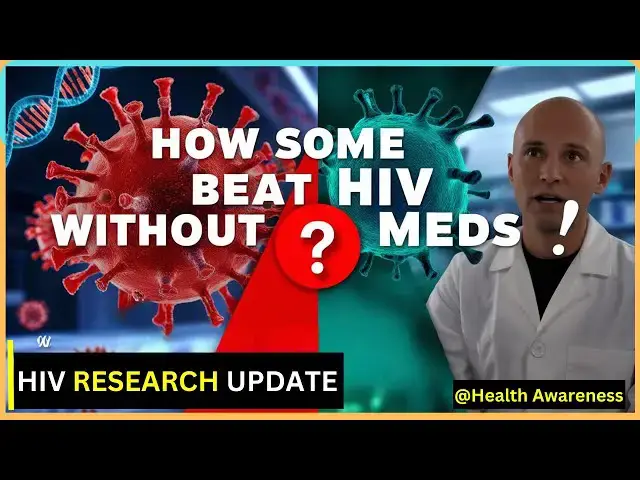0:00
for decades researchers have explored
0:02
why some HIV positive individuals
0:04
naturally resist AIDS progression even
0:07
without anti-retroviral therapy art a
0:10
recent multiomic study by the IRSC Kika
0:12
AIDS research institute sheds light on
0:14
the unique immunity of these rare
0:16
individuals called vmic non-progressors
0:19
vnps understanding their resistance to
0:21
disease progression could open new doors
0:25
treatments the significance of
0:27
anti-retroviral therapy and limitations
0:31
since its Advent in 1987 art has been
0:34
revolutionary for HIV management turning
0:36
it from a fatal diagnosis into a
0:38
manageable condition despite this some
0:41
patients on Art struggle with partial
0:43
immune recovery leaving them vulnerable
0:46
issues this Gap underscores the need to
0:49
explore alternative mechanisms of HIV
0:51
control such as those found in
0:57
nonprogressors vmic nonprogressors or VM
1:00
PS are exceptionally rare comprising
1:02
less than 0.1% of all HIV positive
1:06
adults While most HIV infected
1:08
individuals progress toward AIDS due to
1:10
declining immune function vnps maintains
1:13
stable levels of CD4 plus T cells and
1:15
resist disease progression even with
1:19
replication this resilience pequ
1:21
researchers interest leading them to
1:23
investigate what sets vnps apart from
1:27
progressors key findings from the
1:30
is in the study titled host genetic and
1:33
immune factors Drive evasion of HIV 1
1:36
pathogenesis in vmic non-progressors
1:38
researchers applied multiomic analysis
1:43
progressors multiomic analysis
1:46
integrates various biological data like
1:48
genomics and immune profiling to provide
1:50
a comprehensive view of how genetic and
1:52
immune factors work together to protect
1:56
AIDS the genetic Factor the ccr5 delta
2:01
mutation one major Discovery was a
2:04
genetic link vnps were more likely to
2:06
carry a mutation in the ccr5 gene known
2:09
as Delta 32 with 53.8% of vnps having
2:13
this variant compared to only 16% of
2:16
progressors the ccr5 Delta 32 variant
2:20
affects the ccr5 receptor which HIV
2:23
typically uses to enter immune cells
2:25
individuals with this mutation exhibit
2:27
lower ccr5 expression on CD4 Plus plus T
2:30
cells reducing their susceptibility to
2:32
HIV infection at the cellular level y
2:38
matters the lower presence of ccr5
2:41
receptors on immune cells means HIV has
2:43
fewer doorways to infect these cells
2:46
this reduced entry point combined with
2:47
the mutation's effect on immune response
2:50
helps vnps keep HIV at Bay without
2:53
art this discovery highlights the
2:56
potential of gene-based treatments
2:58
targeting the ccr5 receptor
3:00
cellular immunity lower HIV DNA in blood
3:05
cells Beyond genetics vnps showed
3:08
significantly lower levels of HIV DNA in
3:11
their peripheral blood mononuclear cells
3:13
which include various types of immune
3:15
cells as well as in their cd4t cells
3:18
this indicates that vnps may experience
3:21
partial cellular protection against HIV
3:23
further contributing to their resistance
3:26
progression immune response patterns in
3:30
another unique feature of vnps lies in
3:33
their immune response higher levels of
3:35
naive cd8 plus t- cells vnps had higher
3:38
numbers of naive cd8 plus T cells
3:42
progressors naive cd8 plus T cells
3:45
haven't yet encountered antigens
3:47
substances that trigger immune responses
3:49
and this higher count suggests vnps
3:51
might be better prepared to respond to
3:53
new threats including HIV
3:56
mutations fewer activated memory cd8
3:59
Plus t- cells memory te- cells are
4:01
typically primed to fight previously
4:03
encountered antigens vnps emps have
4:06
fewer of these indicating their immune
4:08
systems avoid chronic activation a state
4:11
that's associated with immune exhaustion
4:12
and HIV positive individuals it these
4:16
characteristics suggest that by
4:17
maintaining a lower Baseline of immune
4:19
activation vnps prevent chronic
4:22
inflammation and immune exhaustion two
4:24
factors that significantly contribute to
4:27
progression apoptosis in CD 4 plus T
4:31
cells the study also found that vnps
4:34
experienced lower rates of apoptosis or
4:36
programmed cell death in their CD4 plus
4:39
T cells apoptosis is an essential
4:41
cellular process but excessive cell
4:43
death can weaken the immune system by
4:46
preserving CD4 plus t- cells V and PS
4:49
maintain a healthier immune system
4:51
giving them an advantage in the fight
4:53
HIV interferon stimulated genes a unique
4:59
a particularly striking finding from
5:01
single cell RNA sequencing in vnps was
5:04
the downregulation of interferon
5:06
stimulated genes across multiple immune
5:08
cell types interferons are proteins that
5:12
cells produce in response to viral
5:14
infections typically signaling nearby
5:16
cells to heighten their antiviral
5:18
defenses this effect was observed in
5:20
various immune cells including aloid
5:24
cells CD4 plus T cells cd8 plus T cells
5:30
are NK natural killer
5:32
cells by limiting interference signaling
5:35
vnps seem to avoid overactivating their
5:37
immune systems helping them maintain
5:39
immune balance even in the face of
5:43
replication gut integrity and immune
5:47
activation another important finding was
5:49
the link between gut health and immune
5:51
activation vnps had lower levels of
5:54
zonulin a protein that can indicate gut
5:56
barrier disruption this suggests vnps
5:59
May experience less leakage but from the
6:01
gut which is significant because gut
6:03
Integrity is closely tied to
6:05
inflammation and immune Health
6:07
maintaining a healthier gut barrier
6:08
likely reduces chronic immune activation
6:11
providing vnps with an added layer of
6:13
Defense tryptophan metabolism lower
6:18
acid the metabolomic analysis of vnps
6:22
revealed lower levels of anthranilic
6:23
acid a product of tryptophan degradation
6:27
elevated anthranilic acid levels have
6:29
been linked to immune activation and CD4
6:31
plus t- cell loss in HIV progression
6:34
lower levels of this byproduct in vmps
6:36
May further explain their resilience as
6:38
it suggests reduced immune activation
6:43
depletion lessons for future HIV
6:47
treatment the findings offer new
6:49
insights into HIV resistance providing a
6:51
road map for future treatments that
6:55
characteristics by designing therapies
6:57
that lower chronic immune activation
6:59
reduce gut barrier disruption and
7:01
promote CD4 plus T Cell preservation
7:04
researchers hope to replicate the vnps
7:07
resilience in the broader HIV
7:09
population the study's authors believe
7:12
these insights could eventually lead to
7:13
treatments that reduce Reliance on Art
7:15
and improve quality of life for HIV
7:19
individuals the multiomic analysis of
7:22
vomic nonprogressors has uncovered a
7:24
unique combination of genetic and immune
7:26
mechanisms that protect these rare
7:28
individuals from AIDS
7:30
from the ccr5 Delta 32 mutation to
7:33
Unique immune responses and gut health
7:35
markers vnps provide a powerful model
7:40
interventions This research not only
7:42
adds a new dimension to our
7:43
understanding of HIV but also points
7:46
toward Innovative treatment Pathways
7:47
that could help Millions manage HIV
7:50
without the need for lifelong
7:53
therapy and that is it in today's video
7:56
don't forget to subscribe for more
7:57
updated videos and if you enjoy this
7:59
content like comment and share


